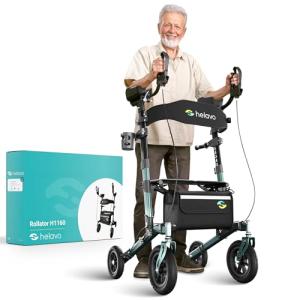Why People Are Talking About Ergonomic Walker This Moment
The Benefits of Non-Slip Walkers: Enhancing Mobility and Safety for All
As we browse through the diverse landscape of mobility aids, one essential product stands apart: the non-slip walker. This vital tool not just help those with limited mobility however likewise promotes independence and safety. In this post, we will dive into the advantages of non-slip walkers, the different types available, and what features to try to find when selecting the ideal walker. Along the way, we will answer regularly asked questions and offer insights that enhance understanding of this essential mobility device.
Why Choose a Non-Slip Walker?
Non-slip walkers are particularly created with security in mind. Slips and falls can cause serious injuries, particularly for elderly individuals or those recuperating from surgery. Integrating anti-slip features into a walker can considerably minimize the danger of accidents, making it a vital option for anybody in need of assistance. Here are a few reasons that a non-slip walker is a worthy financial investment:
- Enhanced Stability: Non-slip grips and rubberized wheels supply superior traction on numerous surfaces.
- Improved Safety: The design lessens the possibility of slips, providing users self-confidence as they move.
- Increased Independence: Those who might have formerly counted on caretakers can gain back some degree of autonomy.
- Versatile Design: Non-slip walkers can be tailored to fit a series of individual needs and preferences.
Kinds Of Non-Slip Walkers
Non-slip walkers can be found in numerous designs, each customized to accommodate different mobility needs. Below is a contrast table highlighting the most typical types of non-slip walkers readily available:
Type of Walker
Features
Perfect For
Price Range
Standard Walker
Four legs, lightweight, rubber tips
General use, moderate assistance
₤ 50 – ₤ 100
Two-Wheeled Walker
Two front wheels, 2 rear legs with rubber tips
Individuals who need assistance however can walk
₤ 70 – ₤ 150
Rollator
Four wheels, braking system, seat option
Active people; supplies a rest option
₤ 100 – ₤ 250
Knee Walker
Created for individuals with knee injuries
Short-term recovery from leg or foot injuries
₤ 80 – ₤ 200
Pediatric Walker
Smaller size, vibrant styles
Kids with mobility problems
₤ 60 – ₤ 120
Factors to Consider When Choosing a Non-Slip Walker
Selecting the right non-slip walker can be an overwhelming task. Here are some elements to bear in mind when making a choice:
- User's Weight and Height: Ensure that the walker supports the user's weight and matches their height.
- Kind of Surface: Consider where the walker will be mainly used (indoors vs. outdoors) to select a suitable tire setup.
- Mobility and Weight: If the walker needs to be transported, consider weight and foldability for benefit.
- Adjustability: Look for a walker that can be adapted to the user's particular height requirements, ensuring comfort and safety.
- Additional Features: Some walkers consist of features such as built-in seats, storage baskets, or more advanced braking systems.
Extra Features of Non-Slip Walkers
While examining non-slip walkers, several additional features can enhance user experience:
- Ergonomic Grip Handles: Soft and comfortable grips can minimize pressure on the hands.
- Reflective Materials: Adding increased exposure can help those who may be using the walker in low-light conditions.
- Adjustable Accessories: Consider choices like cup holders, trays, or perhaps oxygen tank holders for included benefit.
- Resilience: Look for walkers constructed from high-quality materials to guarantee lasting usage.
Regularly Asked Questions (FAQs)
1. What is the primary distinction in between a basic walker and a rollator?
- A basic walker has four legs and needs the user to lift it with each action, whereas a rollator has wheels, allowing the user to push it along more easily.
2. Are non-slip walkers suitable for outdoor use?
- Yes, lots of non-slip walkers are designed for different surface areas. It's vital to choose a design with suitable wheels for outdoor surface.
3. Can a non-slip walker be utilized by people who have had hip or knee surgical treatment?
- Definitely. Non-slip walkers provide stability and can be important for those recovering from such surgeries.
4. How do I adjust the height of a walker?
- A lot of walkers come with adjustable legs that enable you to change the height. Describe the manufacturer's guidelines for particular change instructions.
5. Is there a weight limit for non-slip walkers?
- Yes, each walker has actually a defined weight limit. My Mobility Scooters is very important to carefully check this information before purchasing to make sure safety.
6. Can I utilize a non-slip walker in shops or public places?
- Yes, non-slip walkers are developed for usage in numerous environments. Simply make sure the design you select is maneuverable enough for enclosed spaces.
Purchasing a non-slip walker can offer users with enhanced mobility, confidence, and self-reliance. The variety of styles and features available permits users to choose a walker that best fits their distinct needs. By thinking about elements such as weight capacity, adjustability, and extra features, one can ensure that they or their enjoyed ones are safe and comfortable.
For those looking for to restore their independence, non-slip walkers not just aid in mobility however likewise add to a more active way of life. If you or someone you know could take advantage of a non-slip walker, make the effort to explore the alternatives offered— your journey towards increased security and autonomy begins here!
